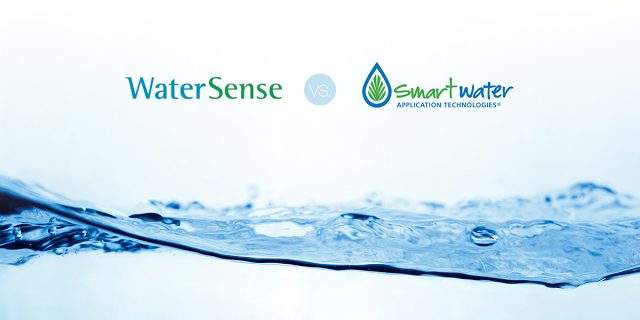You may not be an irrigation or water nerd like us, but if you are, you’ve likely heard of the two major types of water efficiency programs: WaterSense and SWAT. But what are the differences?
First, a bit of historical context.
SWAT History
SWAT, or Smart Water Application Technologies, an initiative of the Irrigation Association (IA), is a national partnership of water purveyors and irrigation industry representatives that began in 2002. Stakeholders developed SWAT testing protocols to assess and document product performance in order to better promote water-efficient technologies. Testing protocols have been developed for products like weather-based irrigation controllers and rain sensors. Water utilities rely on SWAT testing protocols because they provide credible, independent product testing data that validates the water-saving potential of irrigation technologies. To become SWAT tested, the manufacturer must pay for the testing. When SWAT was created, many municipalities used it as a basis for offering rebates on efficient products.
WaterSense History
The Environmental Protection Agency (EPA) created WaterSense in 2006 as the water equivalent of EnergyStar, a voluntary program to promote the efficient use of water. WaterSense is also a broader program, as it covers non-irrigation products like toilets and showerheads. Like SWAT, many municipalities offer rebates on water bills for WaterSense certified products.
The Differences
In broad terms, SWAT came first, and WaterSense adopted SWAT’s testing protocols with a few minor changes.
- Testing versus certification. A product can be WaterSense certified based upon meeting certain requirements. However, WaterSense does not provide the complete testing results. SWAT, on the other hand, does not provide certification. Instead, SWAT reports performance of products without judgment, releasing results to the public. In other words, WaterSense is a pass/fail certification, while SWAT releases complete testing results for buyers to review themselves.
- Minimum runtimes. WaterSense added minimum run times so that sprinklers will apply a minimum amount of water that will soak into the soil.
- Missing data from the reference weather station. Adds requirements to compensate when there is missing weather data.
- Rainfall requirement. WaterSense added a requirement that there be at least 4 individual days with 0.10 inches or more of gross rainfall. This tests how the controller handles rain.
- Order of operations in calculating the water balance. Because these programs are for weather-based or evapotranspiration (ET) controllers, calculating when irrigation needs to occur is a major concern. SWAT calculates the water balance in the following order: ET, rainfall, and then irrigation. WaterSense changed the calculation to the following: ET, irrigation, and then rainfall. SWAT’s approach is to maximize the benefit of rainfall first, then add irrigation.
What does this mean in practice?
The differences between SWAT and WaterSense largely come from the fact that WaterSense was tested in Florida, where it rains regularly. This meant they could not properly test products without removing rainfall largely from the equation, particularly future rainfall. As such, WaterSense controllers do not account for future rain; only how it handles irrigation after a rainfall.
Take the situation where an irrigation schedule is supposed to run at 4 pm, but rain is forecasted to occur at 10 pm. A controller that irrigated at 4 pm would likely pass EPA certification, but receive low scores from SWAT as the controller didn’t account for future rainfall and skip the scheduled irrigation event.
What This Means For You
With competing testing protocols, it can be confusing to know which one to trust. However, here are some guidelines:
- Both programs signal a water efficient product. Because they are based on roughly the same protocols, both programs are excellent.
- Check with your water provider for available rebates. While saving water by itself is admirable, if you are going to pay for new hardware, make sure to see if you can save money on your purchases as well.
- Although SWAT came first, WaterSense has overtaken it as the most popular program for testing the validity of manufacturers’ water saving claims. This is likely due to the wider range of products that WaterSense covers, as well as WaterSense being created by the EPA, a well-known government agency.
- While WaterSense is currently more popular, water municipalities in the west have a higher likelihood of offering rebates based on SWAT.
From time to time Water – Use It Wisely features guest bloggers who write about topics related to water and water conservation. Ben Blackmer is the Director of Product Marketing at Rachio, a Denver-based software and hardware company focused on improving the water efficiency of homes by using innovative products such as a remote-controlled smart sprinkler controller.


